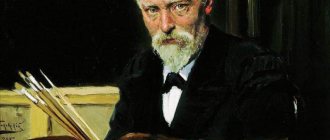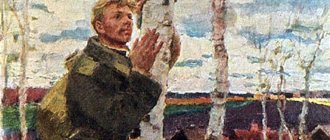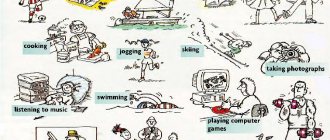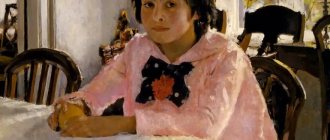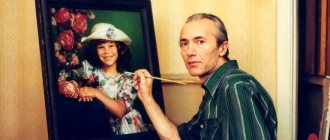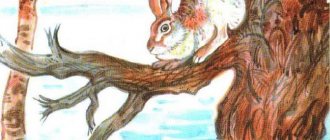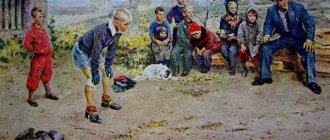Description of the painting by S. A. Tutunov “Winter has come. Childhood". Essay for 2nd grade.
Who painted the picture Winter has come. Childhood
The author of the painting is the Soviet and Russian artist Sergei Andreevich Tutunov (1925-1998). Member of the Union of Artists of the USSR. Repeatedly participated in exhibitions. Today, the author’s paintings are in such large museums as the State Tretyakov Gallery, the Russian Museum in Kyiv, as well as other museums around the world and private collections of collectors from around the world.
The painting on a winter theme, which received a great response from art lovers and is now studied in school, was painted in 1960. Currently located in the Tretyakov Gallery in Moscow.
Description of the painting Winter has come. Childhood
The genre-themed painting by Sergei Tutunov touches the heartstrings. The work is quite simple in concept and plot, but so touching and heartfelt that it’s simply impossible not to get caught up in it. At one glance at this picture, a smile appears, and the consciousness is transferred to memories of one’s children, so touching and funny, or one’s own childhood, when every day the world surprised and delighted with completely unthinkable things.
In the picture we can see a boy standing with his back to the viewer. It is clear that he is still just a child. The boy had just gotten up and was deeply amazed that the world outside the window had completely changed. Just yesterday it was gray autumn, perhaps it was raining, but today the world was covered with a white blanket. There are caps of snow on the ground, the fence, houses, trees.
A boy stands at the window, looking at an extraordinary sight. With one hand he holds the curtain so that it does not interfere with his consideration of every detail of the transformed nature, and he puts the other hand to the window, as if he wants to touch this beauty.
Such a drastic change in the landscape surprises even adults. Winter usually creeps up gradually. Snow falls in small portions and then melts. When the snow piles up large snowdrifts overnight and dramatically changes everything around, it causes a special surge of surprise and joy. What can we say about a small child who was discouraged by the fact that the world outside the window had become completely different.
This picture is not only a touching and funny story, when a child, seeing that winter has come on the street overnight, cannot tear himself away from such a spectacle. The artist approached the depiction of the plot with soul, making it deep and heartfelt. Everything - the thin figure of the boy, the small hand that touched the window - expresses sincere curiosity and bright emotions that are so inherent in children. Adults who have seen a lot in their lives are simply no longer able to be so sincerely surprised and worried.
The author managed to reveal the feelings of a boy who witnessed the first snowy day of the year. Soon, surprise will be replaced by a desire to go outside, play winter games with friends or family, throw snowballs, go sledding, but now he just froze, trying not only to comprehend what had happened, but also to fully enjoy the extraordinary view.
The viewer looks out the window along with the boy. His presence helps us become children ourselves for a while, remember our own feelings and emotions, rejoice at the coming winter, be moved by the naive surprise of a child, indulge in nostalgia and childish joy.
Essay plan Winter has come. Childhood
- Author
- The plot of the picture
- Foreground, boy
- View outside the window, first day of winter
- My impressions of the picture
An essay based on a painting by S.A. Tutunova “Winter has come. Childhood" for 2nd grade
(Option 2)
On the canvas by S.A. Tutunova “Winter has come. Childhood" depicts a boy who is at the window. He had just woken up and went to the window, and there, on the street, the very first snowball was falling. The boy froze at the window, he watches the falling snowflakes, admires the coming winter.
On the other side of the window an incredibly beautiful picture opens up: just yesterday the yard was greyish, but now, as if on a white tablecloth, everything is covered with snow. The snow-white snow is swirling with beautiful fluffy flakes, and the boy is most likely dreaming of winter fun and thinking that soon the earth will be covered with a snow-white blanket and the long-awaited winter will come.
In the distance of the canvas, a village house is barely visible. He's all covered in snow. Leaves that have not yet fallen can be seen on the trees. This suggests that the artist really captured the very first snow, which the little boy frozen at the window likes so much.
This painting reminds us what an incredibly beautiful time of year is coming. All kids love winter because all their cherished dreams come true; winter brings a lot of joy to most people.
An essay based on Tutunov’s painting “Winter has come. Childhood.” 2kl
- Kozlova Alla Vasilievna
- Primary school teacher
- GBOU Secondary School No. 388 of Moscow
- Lesson summary of speech development, grade 2 “Russian School”.
- Essay based on a painting by Tutunov
"Winter has come. Childhood."
- Moscow 2013
- Lesson summary of speech development, grade 2 “Russian School”.
- Essay based on a painting by Tutunov
"Winter has come. Childhood."
Goals:
- Teach children to express their thoughts correctly.
- Enriching children's vocabulary.
- Development of imagination, observation, attention.
- Fostering a caring attitude towards the surrounding nature, love for it and for the Russian language.
Tools: illustrations of paintings and photos of winter nature, audio file “Tchaikovsky “The Seasons”, projector, laptop, plasticine.
During the classes.
1.Organizing moment.
- Collect the word and find out the topic of our lesson:
- The city where the Olympics will be held in 2014? — SOCHI
- A particle that is written separately with verbs? - NOT
- The letter that stands in the alphabet after the one with which our city begins?
— M
OSCVA -
N
- Riddle: Not prickly, light blue hung on the branches... AND
HER The first letter of the answer. - The sixth letter in the alphabet? — E
-What word did you collect? (Essay) And the topic outside the window... What will our essay be about? (About winter). (Slide 1)
2. Updating knowledge.
Didactic game “Correct the mistake.” Work in pairs. (Slide 2). A sheet of text is handed out to the desk, in which you need to correct the mistakes made by Dunno.
- Guys! Dunno wrote a letter about winter and, as usual, got everything mixed up. Find errors and fix them.
«The first month of winter is called September. When the weather begins to get cold, people immediately put on warm clothes: fur coats, mittens, hats, shorts, scarves.
In winter, children ride sleds, skis, bicycles, and horse-drawn horses.
They make a snow woman, swim in the sea, sunbathe, and build fortresses out of snow. To avoid catching a cold, you need to eat one icicle every morning. Winter is a wonderful time of year!”
Examination. Explaining to students the choice of the correct spelling and word.
— Do you agree with Dunno’s last proposal? Why do you love winter?
- Remember the poems that we taught about winter and listen to how the poet describes this phenomenon... (children read passages by heart or the teacher). (Slide 3)
-Now listen to how composer P.I. Tchaikovsky depicted winter with the help of music. Close your eyes and enjoy the beauty of music. (Listening to the soundtrack). What did you present? What picture would you paint?
3. Goal setting.
— We listened to how masters of words and music described winter.
Open the art gallery in the textbook and find a reproduction of the artist Tutunov’s “Winter has come. Childhood.". We also have to depict winter. How? (students independently set goals “to describe the picture, depict using words, sentences...”).
The teacher gives a little information about the artist and his work. (Slide 4)
“Sergei Andreevich Tutunov, born October 30, 1925 in Moscow. He was a very hospitable and kind person, often inviting many to live at his dacha, where
at a table in a large room .
Having bought this dacha, there were only 3 rooms, and after 11, a workshop appeared. The artist did all this with his own hands. In the artists’ village they joked that Sergei Tutunov would soon even build a helipad. While living at the dacha, the artist admired nature. He passed on his love for the surrounding nature to one of his three sons. His son, Andrei Tutunov, also became an artist - a painter, and loves to depict flowers. (Slide 5) The Tretyakov Gallery bought the first painting “Winter has come” from my father.
Childhood.” (in the textbook)
-The artist Tutunov depicted his childhood memories of the first snow in the picture.
-Signs of winter in the picture?
-What is shown? (the boy at the window, woke up and looks out the window, surprised..)
-Describe the boy. What are you wearing? Why? How is it worth? Where is he looking? How does he look?
- -Why is he surprised? (the first snow fell)
- -Can you imagine what he saw in the yard yesterday?
- — How did the snow that fell today change the view from the window?
- — Do you like this picture?
- What’s the boy’s mood? What is he thinking about?
6. Vocabulary work (words are written on the board).
Covered, decorated, b..lym-b..lo, sparkling, dancing snowflakes, leh.., m..roses
- Physical exercise. Game "Winter Hide and Seek".
Children clap their hands if they hear words related to winter. If not, they hide, crouch. ( Snowflake, warmth, New Year, sled, ice, heat, mittens, tulips, snowman, Santa Claus, falling leaves, peaches, sunbathing, snowfall, skis).
Finger gymnastics “Skiers”. Place your index and middle fingers on the counting sticks and slide along the desk, changing “legs.”
- Compose and write down a story based on the picture. Select three parts: introduction, main, ending. (weak students can be offered the beginning of each part on cards).
-Whoever quickly completes the task can make a snowman from plasticine.
9. Summary. Reflection.
— What topic are your writings devoted to?
— Which composer’s music helped you better describe the winter picture? What is the name of his work?
-Who can praise themselves for the work done? And who didn’t succeed? Why?
-Who wants to read their essay?
- Thanks to all. Well done everyone!
Source: https://pedsovet.su/load/238-1-0-35949
Description of the painting by Sergei Tutunov “Winter has come. Childhood"
Winter has come. Childhood, 1960, Sargey Tutunov, Tretyakov Gallery. Photo: https://ru.wikipedia.org
| Name | Winter has come. Childhood |
| Country, artist | USSR, Sergey Tutunov |
| Year | 1960 |
| Genre | realism, landscape |
| Where is it stored? | State Tretyakov Gallery, Moscow |
| Materials | canvas, oil |
Have you ever watched the first snow?
This is a fabulous sight not only for a child, but also for an attentive adult who managed to stop and see a fluffy white miracle fluttering from the sky. On this morning in late autumn or early winter, the boy woke up and saw myriads of huge fluffy snowflakes waltzing in the quiet air. He stands at the window and looks at them without taking his eyes off.
As if smoothly waltzing up and down in the air, they still fall and cover the ground, tree branches, roofs of houses and even the top of the fence visible from the window with a white shaggy blanket.
An incredible, fabulous whirling takes away all thoughts, all problems, all worries and hypnotizes with its quiet whirling.
The last withered leaves have not yet fallen on the trees and bushes, as a reminder of the autumn that has just happened here. Large flakes of snow form a magical veil, through which distant courtyard buildings are almost invisible.
The boy was still in his pajamas, his hair was tousled, he jumped out of bed and froze at the huge window, placing his hands on the glass. Apparently this is the first snow this year. He is fluffy, white and friendly.
The boy will wash his face, comb his hair, have breakfast, get dressed and go outside. There he will roll around in the snow, play snowballs or build a snowman, ride a sled or simply run on a blanket of snow. In the meantime, he looks at the snow and admires the change in nature.
For him, all this is fabulous and inexplicably interesting. A cloudy sky, the last leaves on the trees and fluffy snowflakes whirling in the air like white birds. And only the slight coolness of the glass under your hands and the view from the window remind you of the winter frost.
There will be many more such morning snowfalls ahead, but the first one is always, at any age, an immersion in a fairy tale. An incredibly beautiful, snow-white, cold fairy tale.
The painting was painted by the master in 1960, and in the same year it was acquired by the Tretyakov Gallery. This is the first painting by Sergei Tutunov, highly appreciated by Tretyakov experts.
Looking at it, you involuntarily begin to imagine the first white snow flakes swirling chaotically up and down. They sit on the face raised to the sky and hands, small cool creatures and immediately turn into droplets of water.
